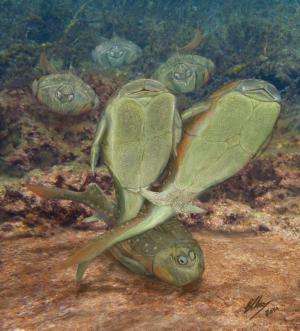Sex? It all started 385 million years ago (w/ Video)

It may not have been love as we know it, but around 385 million years ago, our very distant ancestors—armoured fish called placoderms—developed the art of intercourse.
So suggest a team of evolutionary scientists, who point to the fossil of a placoderm species blessed with the name of Microbrachius dicki.
Measuring about eight centimetres (four inches) in length, M. dicki lived in habitats in modern-day Scotland—where the first specimen was found in 1888—and in Estonia and China.
Placoderms have previously been found to be the most primitive jawed animal—the earliest known vertebrate forerunner of humans.
But they now have an even more honoured place in the book of life.
Microbrachius is the first known species to copulate in order to carry out internal fertilisation, according to a paper published on Sunday in the journal Nature.
Male fish had bony, L-shaped genital limbs called claspers which transferred sperm into the female, a more effective way of reproduction compared to spawning in the water, the study says.
The females, for their part, developed small, paired bones with which they locked the male organs in place in order to copulate.
"'Microbrachius' means little arms, but scientists have been baffled for centuries by what these bony paired arms were actually there for," said John Long, a professor of palaeontology at Flinders University in Adelaide, Australia.
"We've solved this great mystery because they were there for mating, so that the male could position his claspers into the female genital area."
Until now, it was thought internal fertilisation occurred much later in the evolutionary tale of vertebrates.
Covered with thick, bony plates covering the head and trunk, placoderms ruled the world's oceans, rivers and lakes for around 70 million years.
They were then were wiped out around 360 million years ago in a mysterious mass extinction.
For decades, they were deemed by many palaeontologists to be a curiosity—an evolutionary branch that failed.
But work by Long and others found them to be far more important.
The critters handed on features such as jaws, teeth and paired limbs that are seen today in reptiles, birds and mammals, including humans.
If the new study is right, the "claspers," over hundreds of millions of years, evolved into the penis.
Microbrachius' copulatory skill was uncovered last year when Long stumbled across a fossil in a collection at the University of Technology in Tallinn, Estonia.
Males and females probably had sex side by side, with their bony jointed genitals locked together, according to the new investigation.
"This enabled the males to manoeuvre their genital organs into the right position for mating," Long said.
The position looked, well, rather weird, he admitted.
"With their arms interlocked, these fish looked more like they are square-dancing the do-se-do rather than mating.".
More information: Nature. DOI: 10.1038/nature13825
Journal information: Nature
© 2014 AFP





















